Discover the Secrets of Steve Vai’s Rhythm Guitar Prowess
Learn the virtuoso’s highly appealing and inventive rhythm playing approaches on his masterpiece, 'Passion & Warfare.'
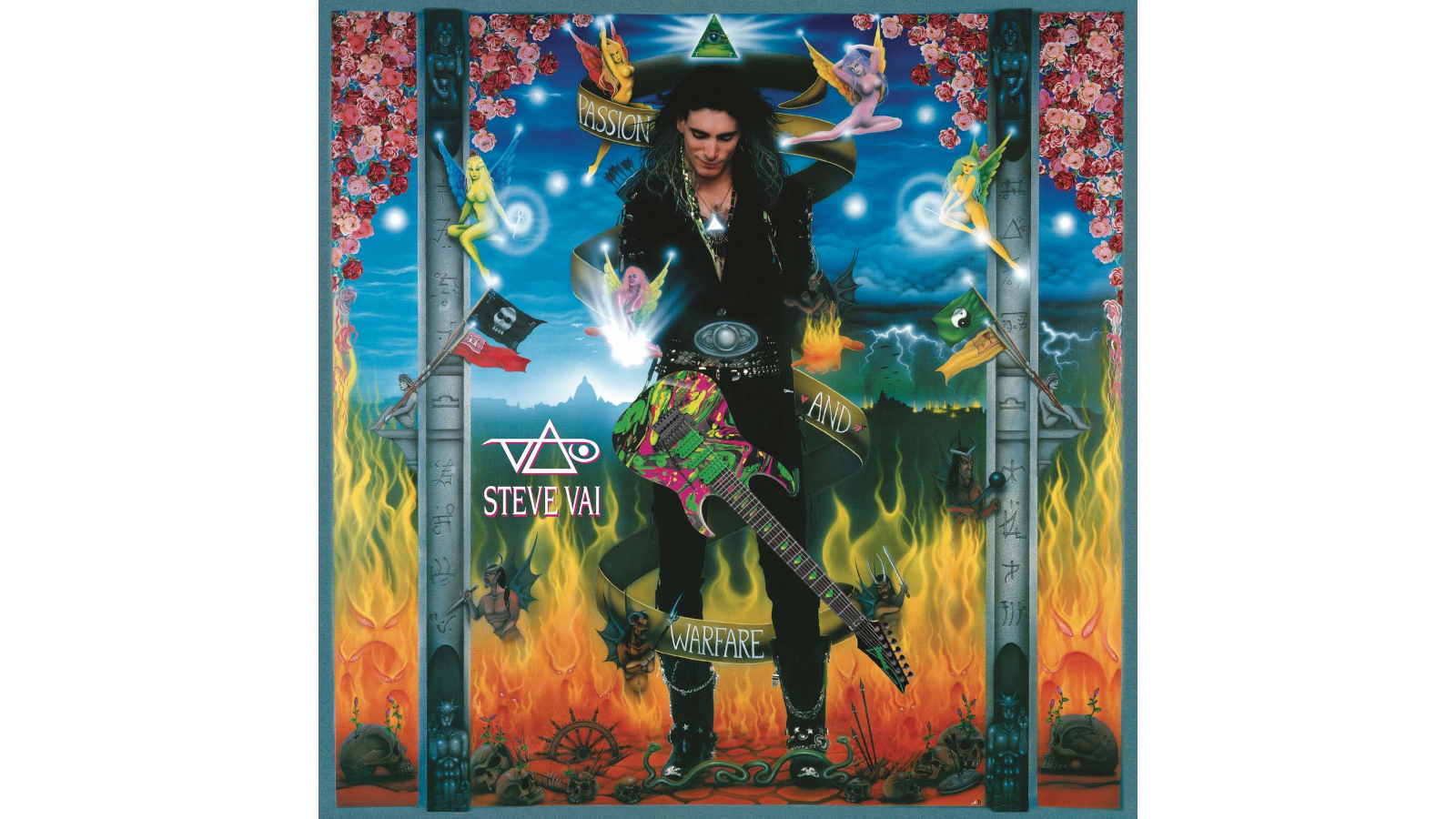
Steve Vai’s epic 1990 release, Passion & Warfare, left the guitar community and anyone else within earshot slack-jawed.
From the first notes following the drum roll in “Liberty” to the final crescendo of “Love Secrets,” Passion was a feat of artistic excellence. A collection of music of this magnitude has been tirelessly, yet deservedly analyzed from every angle.
Nevertheless, there’s an element that’s not in the conversation enough – Steve’s rhythm playing.
Originally hailing from Carle Place, New York, less than an hour east of New York City, Stevie Vai had that groove that Ace Frehley was singing about in ‘78 embedded in his musical DNA, and it’s all over this record.
It’s not out of the question to think a study in Steve Vai’s rhythm playing would be ruled by outlandish syncopation and otherworldly chord voicings.
While Mr. Vai is more than capable of such havoc, and this lesson will examine some choice examples, you’ll find many of Steve’s approaches to his rhythm playing are culled from staples and not alien love secrets.
The gold to uncover in this lesson is how Vai peppers a well-documented ironclad foundation in all things guitar with next-level rhythm techniques while never leaving the song nor the listener behind.
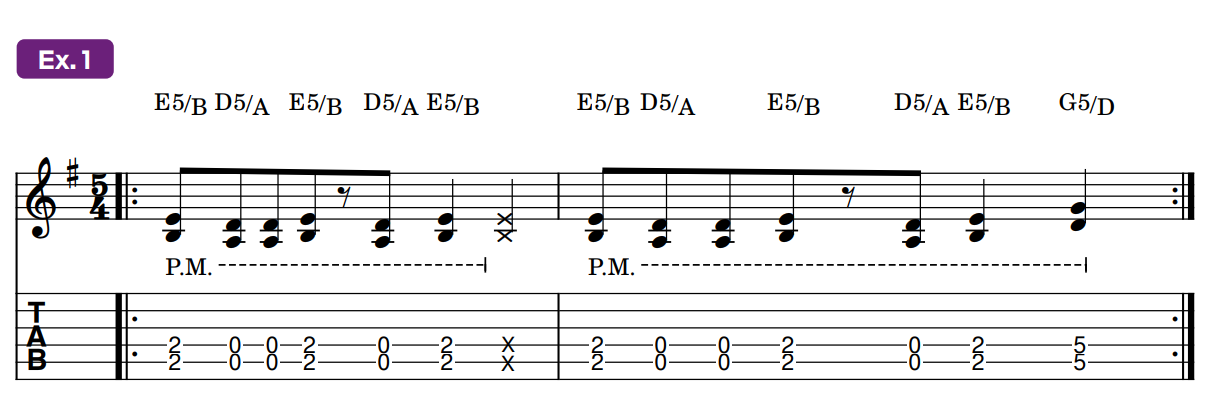
Perhaps Vai’s greatest rhythmic attribute is his command of his rhythmic groove, or pocket, within his energetic and invigorating compositions. Ex. 1 is a good illustration of this approach, with an odd-meter power-chord riff similar to one heard in “Greasy Kid’s Stuff.”
Though in 5/4 meter, this palm-muted groove in the key of E minor is inviting to play, with its inverted power chords voiced as perfect 4ths intervals.

Mixing three-note power chords with some slippery single-note riffing on the low E string, Ex. 2 reveals a reworking of a riff from “Erotic Nightmares.”
Parked in 1st, or “open,” position, this riff, which is based on the A Aeolian mode (A, B, C, D, E, F, G), slithers between commanding A5 and F5 chords and variations of palm-muted sequences made up of E, F, G on the 6th string before resolving the rhythmic tension with overdrive-friendly voicings of Csus4 and G5.

Inspired by the verse riffs heard in “The Audience is Listening,” Ex. 3 keeps you in the key of A minor and the open position with an uptempo sequence of A5, G5 and C5 chords along with palm-muted open low E notes before leaving you to shift up to the 12th fret to play the 4th-string-rooted, high-voiced D5 and C5 chords.
Both examples are rock guitar 101 skeletons, but all Vai in heart and soul.
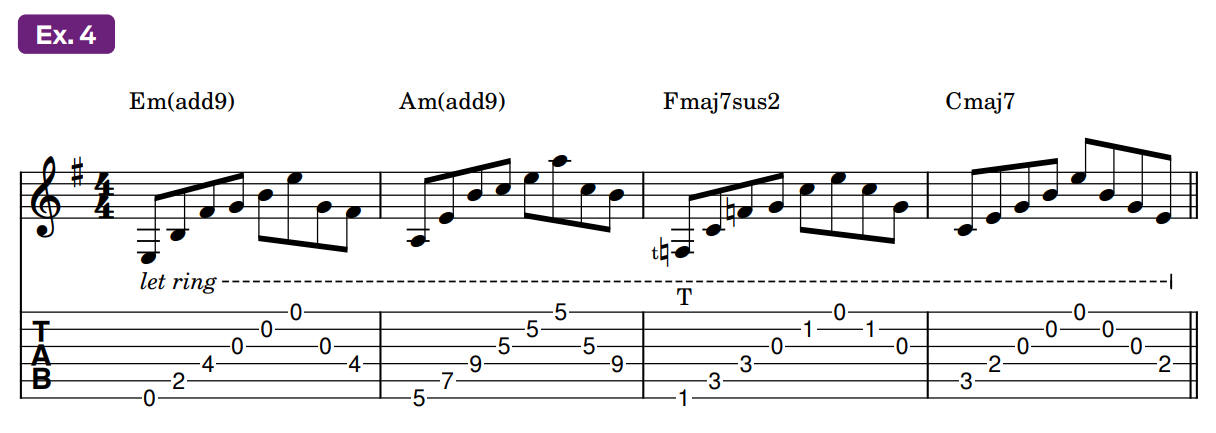
Moving a few steps past two- and three-note power chords and cleverly placed palm mutes, Ex. 4 shifts a few gears, regarding tone and technique.
Played with a clean sound, this four-bar arpeggiated idea in the key of E minor is patterned after the rhythm track Steve played at the top of “For the Love of God’’ and makes use of careful barring and arching while introducing the sound of major and minor 2nd intervals.
To perform these voicings, your fretting fingers need to “stand tall” and cannot lean diagonally, in a way that unintentionally deadens adjacent strings.
As for the makeup of these chords, bars 1 and 3 have minor add9 voicings that contain minor 2nd intervals, half steps, while the Fmaj7sus2 in bar 3 has a major 2nd, or whole step.
This kind of usage of 2nd intervals within chord voicings injects a tightness to the sound of Steve’s voicings, helping to contribute to the uber-coolness of his music.
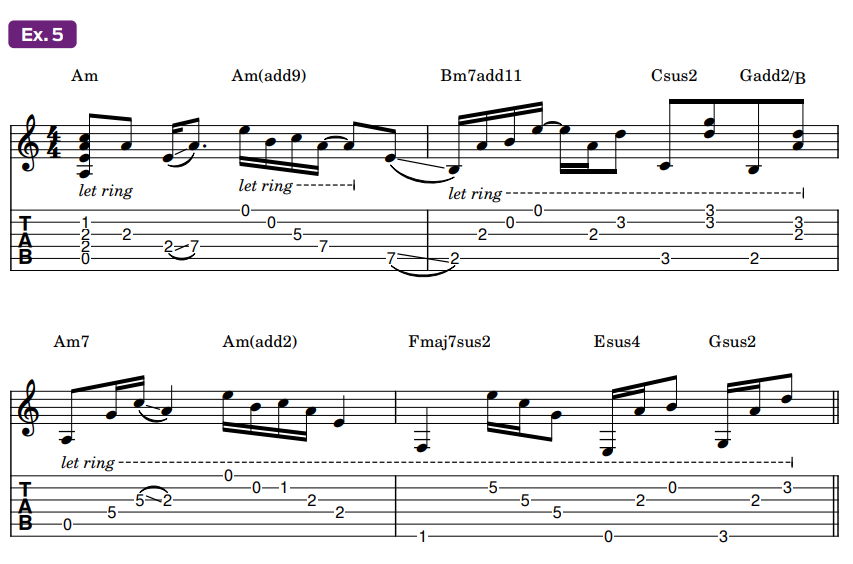
Ex.5 takes the arpeggiation platform a step higher with a figure inspired by the rhythm part heard at the top of “Blue Powder.”
Set in the key of A minor, the added movement horizontally up and down the neck will further challenge the notion of careful fretting.
A useful trick in this situation is to not hold yourself to fretting entire chords before playing the first note of an arpeggiation pattern. This approach is even more valuable when open strings are involved.
Forming the chord as you play will afford you a little extra time, so that you can better focus on the accuracy of the fretting.
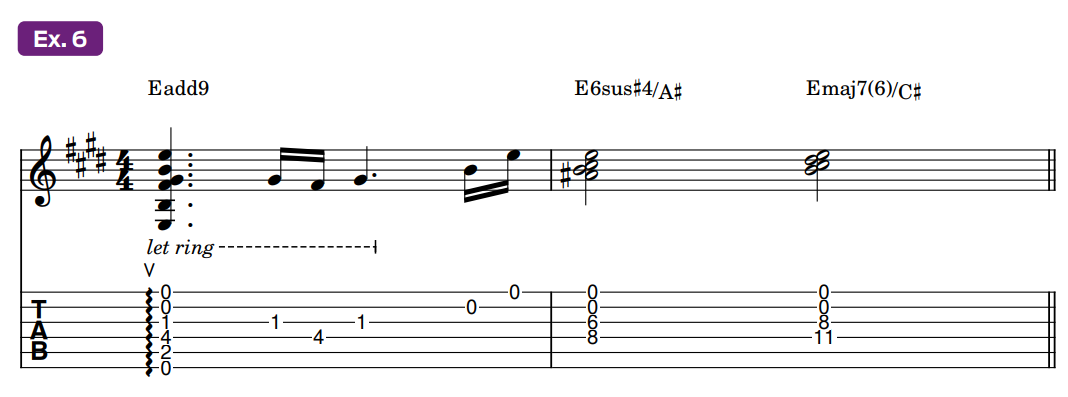
Circling back to “nested” 2nd intervals, Ex. 6 is informed by a moment from Steve’s acoustic guitar comping in “The Riddle.”
The opening Eadd9 is from Ex. 4’s playbook, regarding the voicing, and the next two chords combine open strings with notes fretted higher up the neck to generate clusters of 2nds.
For instance, check out the minor 2nd between the 8th-fret A# and the open B string in the E6sus# 4/A# voicing at the beginning of bar 2.
To double your pleasure, the following chord, on beat 3, includes what’s called a cluster, given its adjacent and compounding 2nd intervals: B - C#, C# - D# , D# - E.
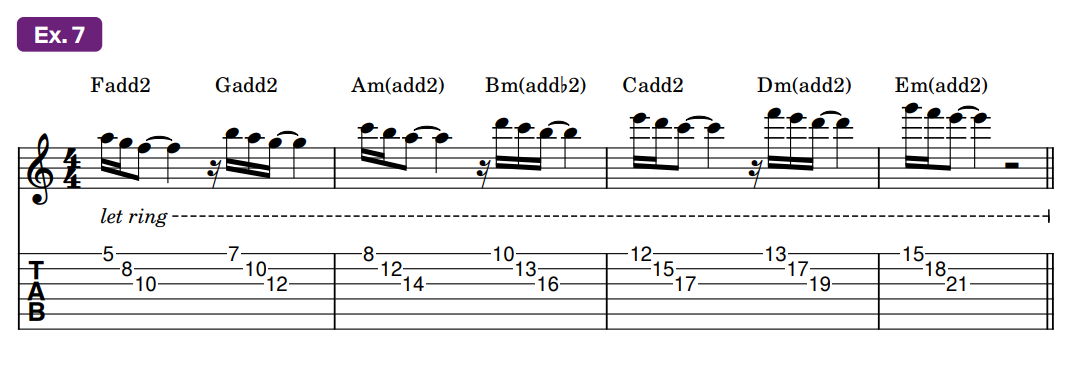
If you find the sound of clusters alluring, jump over to Ex. 7, where you’ll find an ascending chord scale consisting of three-note diatonic clusters based on the F Lydian mode (F, G, A, B, C, D, E).
As you play the seven chords up the neck, adjust the fingering of the middle note on the B string to be played either with your 2nd or 3rd finger.
If the Bm(addb2) chord in bar 2 creates a feeling of déjà vu, it’s because it’s what Steve plays sparingly during the opening riff to “The Animal.”

And if our previous example wasn’t enough to convince you of a cluster’s value, Ex. 8 takes its cue from the infectious breakdown in “I Would Love To.”
To play this and Ex. 7, keep in line with the tactic of fretting the chord as you play it while holding down the notes as long as you can.
The sonic charm of clusters is the result of the chord tones ringing together.
When playing Ex. 8, keep your fret hand’s 4th and 3rd fingers planted on the B and G strings’ 22nd and 21st frets as you maneuver through bars 1 and 2.
In bars 3 and 4, hold down the 15th-fret D with your 1st finger as you fret the following 17th-fret C with your 3rd finger.
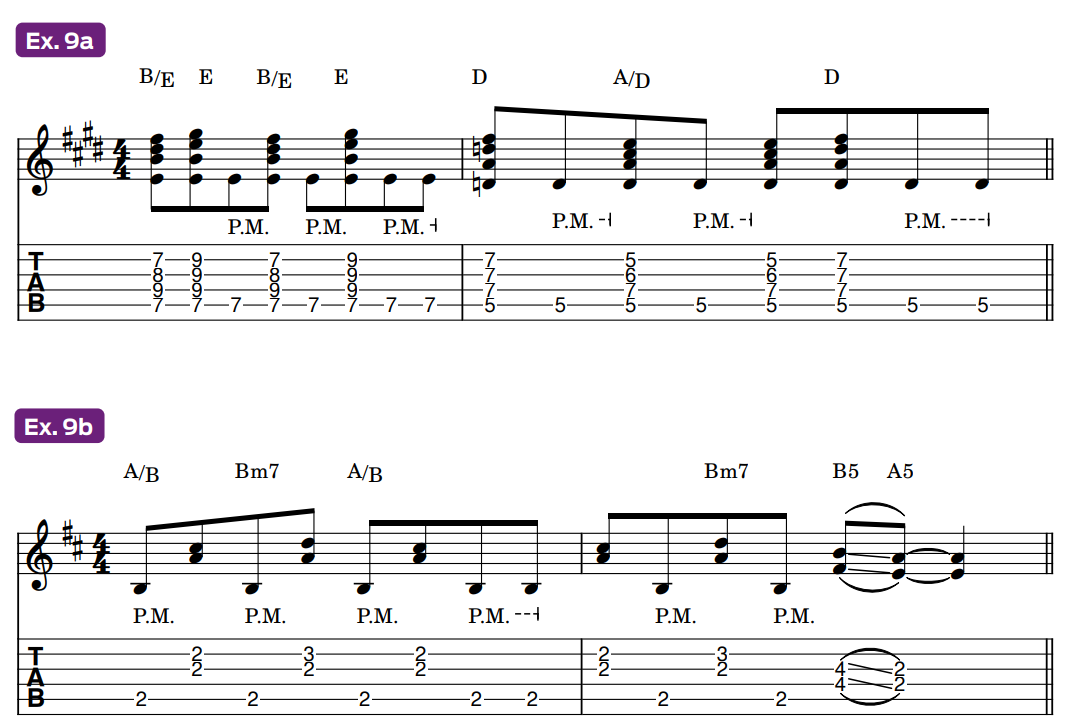
Staying with “I Would Love To,” we’ll show you another great-sounding technique from Steve’s bag of rhythm guitar tricks.
Examples 9a and 9b illustrate chord work that moves quickly between two related voicings to create a sub-melody while alternately “chugging” on a palm-muted 5th-string root note.
Ex. 9a demonstrates the concept with E- and D-rooted chords, ping-ponging between B/E and E then A/D and D. Ex. 9b does a similar alternation with two-note voicings of A/B and Bm7.
In this case, use an index-finger barre for the 2nd-fret notes, as this will set you up nicely for the descending slide of perfect 4ths at the end of bar 2.

Adding to the long list of disciples of Jimi Hendrix, Vai has recorded a handful of performances that make use of the time-honored bluesy and melodic clean-tone rhythm guitar approach pioneered by Curtis Mayfield that Jimi made standard fare.
Ex. 10 recalls a moment heard in “Sisters,” with a I - V progression in the key of G (G - C) that’s treated with must-know Hendrix-isms in bar 1.
Still, in bar 2 you’re in Vai’s world, with fretted root notes held on the lower strings as you play natural harmonics (indicated by diamond-shaped noteheads) on the middle and higher strings.
Once again, arching your fretting fingers is paramount here.

Shifting gears to the idea of moving, or “walking,” bass lines, Ex. 11 is reminiscent of the walking line Steve lays down after it got too loud in “The Audience is Listening.”
You can either fingerpick this – with your thumb handling the bass notes on the 5th and 6th strings and your index and middle fingers plucking the adjacent-string dyads – or hybrid pick it – with the pick on the bass notes and your middle and ring fingers handling the rest.
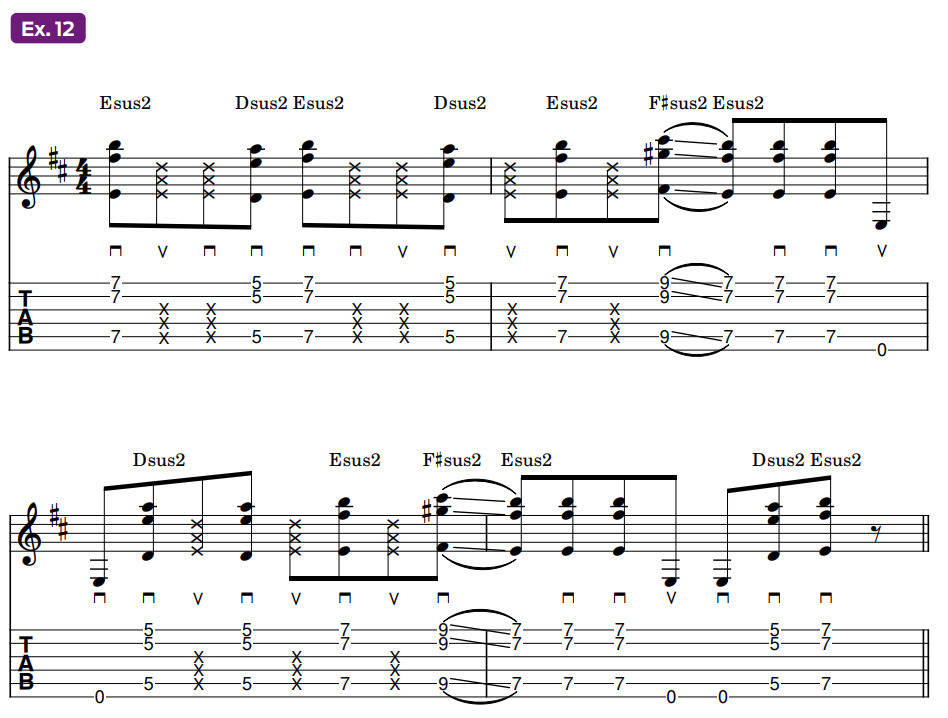
Did you really think a lesson on anything to do with Steve Vai would be nary of at least one moment that stops you in your tracks to ponder if this guy is human or not?
In the spirit of the clean-toned syncopated intro heard in “Answers,” Ex. 12 goes for your strumming hand’s jugular.
This uptempo progression of “spread-voiced” sus2 chords sounds as if it’s in anything but the common time signature it is.
What’s more, every chord played in these four bars is strummed with a downstroke while muting the 3rd and 4th strings. (Tip: Fret each note with a different finger, without barring.)
This passage will create instant chaos if you don’t follow the prescribed fingering approach and learn it at a slow tempo initially, before ramping it up.

If this inspires you to dive deeper into Steve’s rhythm playing, we suggest taking a good listen to some of the works that bookend Passion & Warfare, starting with his first solo album and the pair of David Lee Roth albums Vai appears on.
Going back in time, you’ll find stealth chording in “Viv Woman” from Vai’s 1984 debut, Flex-Able, deep-pocket riffing on tunes like “Bump ‘n Grind” and “Shy Boy” from Roth’s Eat ’Em and Smile and gorgeous arpeggiated layering on “Damn Good,” featured on Roth’s follow-up, Skyscraper, to name a few.
While you’re on the latter, don’t skip over the grooves Steve throws down throughout “Knucklebones” and “Stand Up.”
The instrumental successor to Passion and Warfare, 1995’s Alien Love Secrets, features its own gaggle of rhythm guitar excellence.
From the expansive Hendrix-style comping in “The Boy From Seattle” to the overdriven chording in “Die to Live” and the Wes Montgomery nod through thumb-stroked octaves in “Tender Surrender,” all the way to the onslaught of syncopated downstroked chugs and off-kilter walking bass lines heard in “Kill the Guy with the Ball,” this seven-song EP is Steve Vai extending his best rhythm-guitar foot forward.
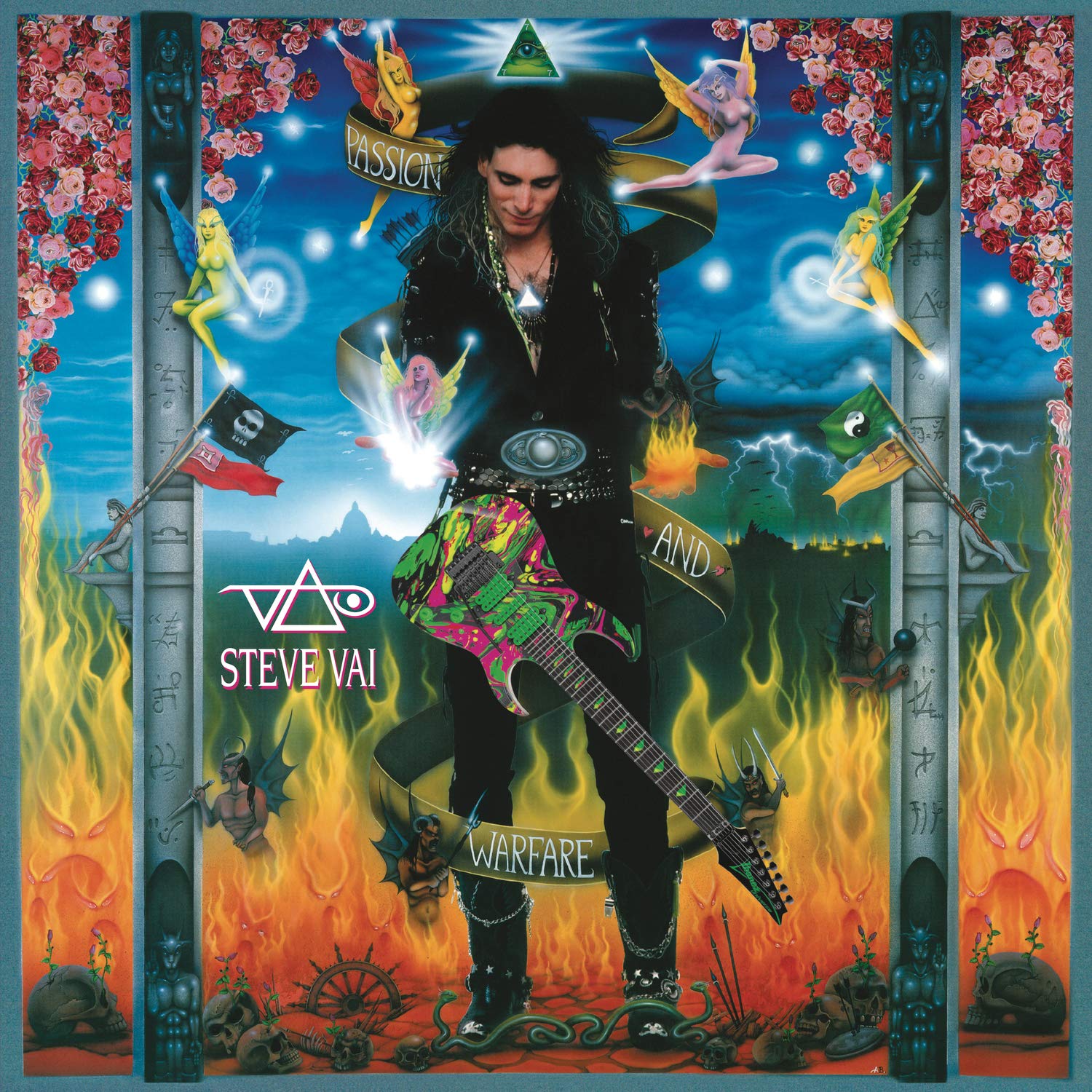
Order Passion & Warfare here.
Get The Pick Newsletter
All the latest guitar news, interviews, lessons, reviews, deals and more, direct to your inbox!
Chris Buono is a top-selling TrueFire Artist with nearly 50 instructional videos, and a featured instructor on guitarinstructor.com. Bookending his years as a Berklee professor, he authored eight books, including the popular Guitarist’s Guide to Music Reading and his most recent publication, How to Play Outside Guitar Licks.
“Write for five minutes a day. I mean, who can’t manage that?” Mike Stern's top five guitar tips include one simple fix to help you develop your personal guitar style
"It’s like you’re making a statement. And you never know where it’ll lead." Pete Thorn shares the tip that convinced Joe Satriani he was the right guitarist for the SatchVai Band











